How to Spy on Your Competitors and Steal Their Traffic

Ever wondered how you are going to get huge streams of traffic to your website?
Your top competitors probably wondered about the same thing, too — at one point.
Only, at this moment, they’re past the “wondering” stage and are already reaping all the rewards — while you’re still stuck with minuscule sales numbers.
If you’re struggling with exactly just that, then don’t worry — the biggest brands in practically every niche were once where you are now.
But rather than relying on guesswork to catch up, why not study what worked for them and try to replicate their results?
Strategy for Competitor Analysis and Traffic Growth Replication
Of course, you don’t need to have an exact carbon copy of their marketing strategies. You just need to apprehend the core components that fuel their campaigns.
Without further ado, here’s how to spy on your top competitors’ strategies and get your fair share of the market.
1. Start from Top to Bottom
If you are going to “borrow” strategies from your competitors, you might as well start from the very top.
With so many business ideas being saturated left and right, you only either strive to be the best or quit being competitive altogether. That’s why you can’t afford to be invested in subpar strategies that get mediocre results.
Fortunately, finding the top competitors in your niche doesn’t have to be rocket science. As a matter of fact, there’s a good chance you’re already aware of who they are.
But in case you don’t, then a round of Google Search will do nicely.
Suppose you’re a catering company based in New York. The keyword “catering in NYC” should reveal some of your top competitors in Google’s local pack.
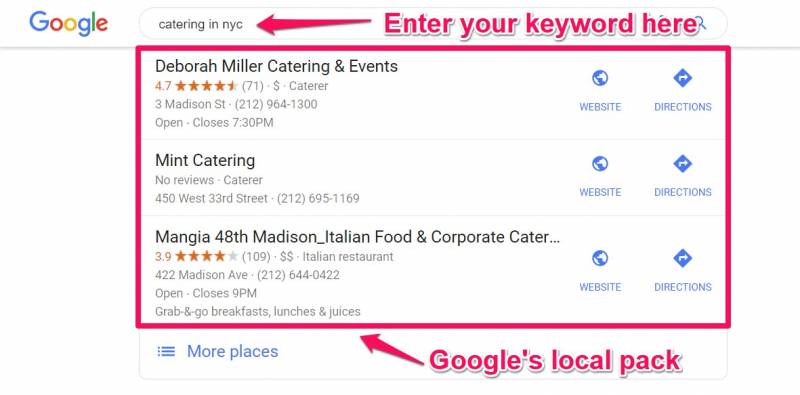
You may also look at review websites like Yelp — or G2Crowd for SaaS businesses — to find your top-rated competitors. If a particular brand appears in both methods, you can bet your bottom dollar that they’re the one to watch.
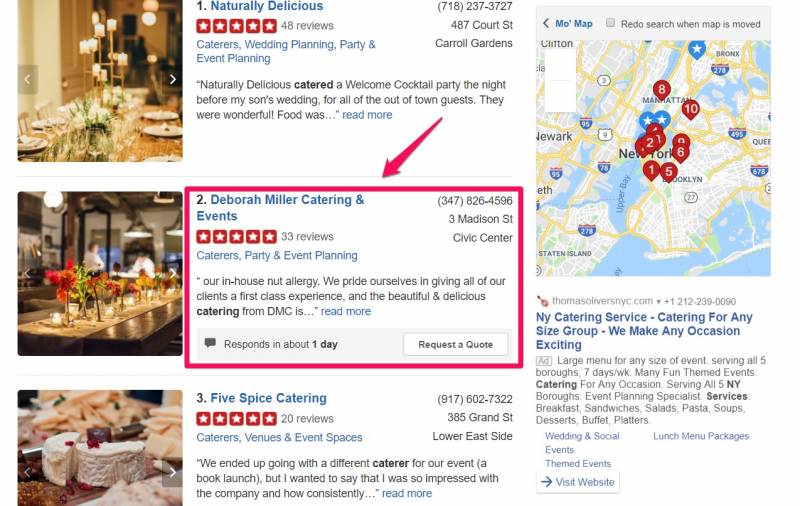
Now that you know how to identify your top competitors, let’s do a quick recon of their backlink profile.
2. Look at Their Backlink Sources
If this isn’t your first rodeo with online marketing, then you should know how important SEO is to your success.
Regardless of your niche, backlinks matched with the right target keywords can make or break your SEO campaign. They allow your website to generate the right kind of organic traffic, which can be converted into email subscribers and paying customers.
However, marketers with SEO experience know how difficult it is to earn high-quality backlinks.
Before you even deal with the challenges of content development for link building, you must first launch an outreach campaign to connect with the websites that can supply you with links. This is a time-consuming, tedious process that doesn’t guarantee positive results.
That is, unless you know your top competitors’ backlink sources.
You don’t need to spend hours of research since your top competitors already did the heavy-lifting for you. You just need a tool like MonitorBacklinks.com to view where they’re getting high-quality backlinks from.
Let’s take a look at our catering competitor, Deborah Miller Catering & Events, on Monitor Backlinks. By viewing their backlink profile and sorting the results according to “Trust Flow,” we can easily scoop up their most valuable backlink sources.
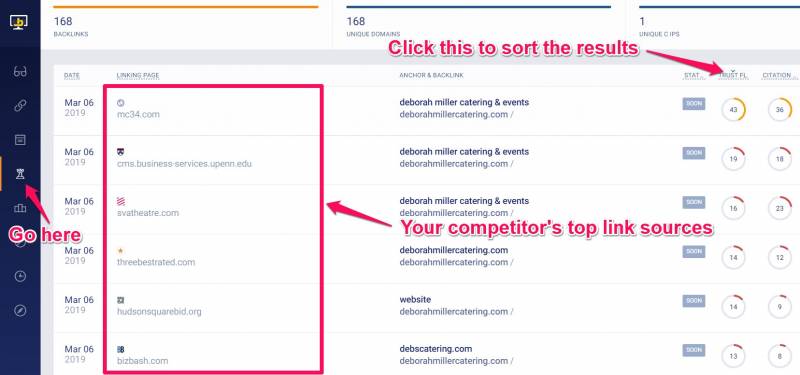
Remember, targeting your top competitors’ keywords would be a bad idea since you could be so far behind — you’ll get better results with something else. Their link sources, however, will definitely help bolster your website’s backlink profile and improve its rank-worthiness in the eyes of Google.
3. Check Their Social Media
Another focal point you should include in your competitor research would be the other brand’s social media marketing strategy.
Remember, the secret to a successful social media marketing campaign is the right kind of content — be it infographics, tutorial videos, text-based articles, or even memes.
If your competitor is doing well on social media, their content mix most likely works. The good news is, this is probably the easiest way to spy on your competitors’ strategies.
Since you already know who they are, all you need to do is view their page and check the content they share.
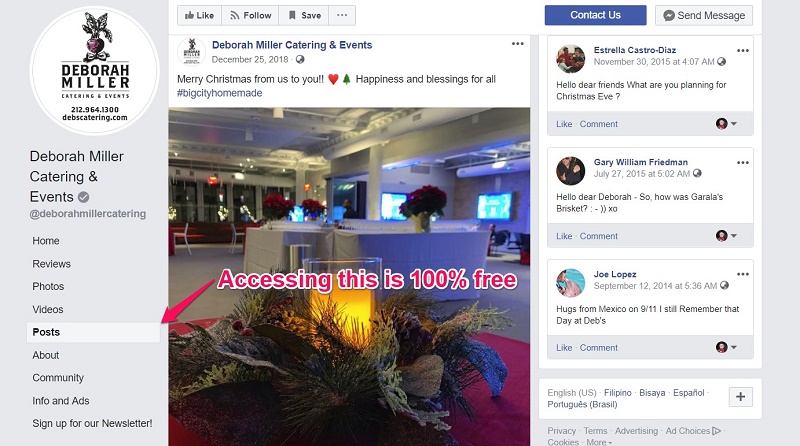
What’s next?
You need to double down on the same content types, but be sure yours are better than your competitor.
Also pay attention to their posting times, especially if you notice a regular publishing schedule on their end.
If they do, chances are they already figured out the social media usage patterns of your ideal audience. You can then model your social media scheduling strategy to align with these behaviors.
4. Use Social Media Listening Tools
Speaking of social media, you should also look for recent mentions of your top competitors.
In doing so, you can identify certain aspects of their business that the online community loves about them. It should also give you a glimpse of the social media influencers and other brands who send them referral traffic.
While there are several tools you can use to monitor your competitors’ recent mentions, the best choice is always the one that gets the job done for free.
Talkwalker.com, for example, has a free tool that can scrape the web for brand mentions on Twitter, blogs, discussion boards, and news feeds. Simply enter the product or brand name of your top competitor, configure your alert settings, and click “Create Alert” to receive notifications in your inbox.
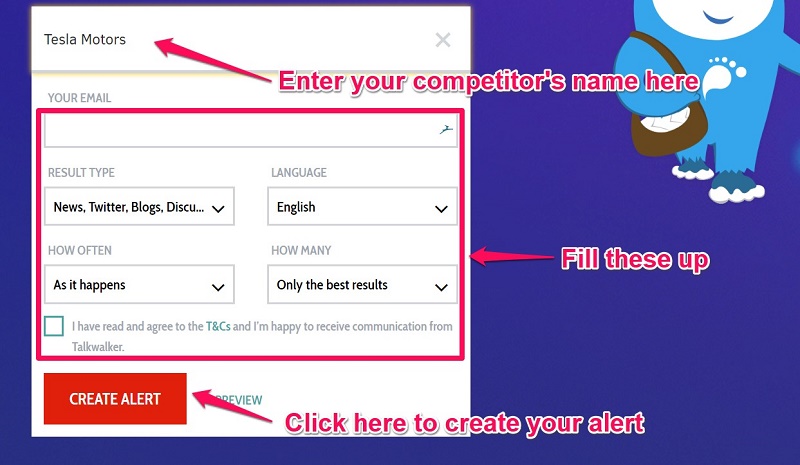
5. Dig Even Deeper
Never underestimate the effectiveness of old-school competitive research in marketing — marching straight to their website and looking at their content.
A good place to start would be their blog, which will tell you everything you need to know about their content strategy. It unveils the content topics they prioritize, their overall “tone,” and the length of their posts.

Don’t forget to closely inspect their most popular content and understand other forms of media they incorporate. Again, these can be infographics, memes, videos, or animated GIFs — whichever maximizes audience engagement and makes them the brand to beat in your niche.
Other elements on their website must be analyzed as well, such as:
- Value Propositions: What are the customer pain points your competitor is targeting? How does your competitor address them on their page?
- Calls to Action: Where are CTA buttons positioned? What are your competitor’s word choices?
- Content Contributors: Does your competitor regularly publish guest posts from content contributors? Any chance you can connect with those authors?
- Trust Signals: Does your competitor showcase certifications? How about customer reviews, user-generated content, or other types of social proof?
- Visual Content: What is the featured visual content on your competitor’s homepage? Do you think you can create something better?
What really matters in the end is for you to outperform them in every single facet of your strategy. If possible, keep up with the latest trends in the marketing industry, from artificial intelligence to blockchain-powered influencer marketing, and take chances.
Keep in mind that online marketing is an ever-evolving landscape. You can either be an early adopter or late laggard — it’s your choice.
Conclusion
Excited to put the strategies you’ve learned to use?
You should be. After all, those strategies are tried and tested by the top-performing brands in your niche.
Just be sure to aim higher and make it a goal to outperform them in every aspect. Only then will you have a fighting chance of overtaking them and snagging the “top brand” title for yourself.
Good luck!




















